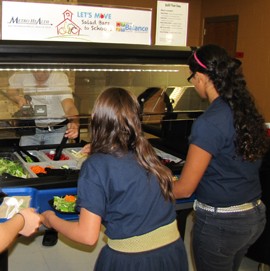Congressional Republicans are hoping to relax requirements aimed at keeping American public school kids healthy. Yes, you read that correctly.
The Healthy Hunger-Free Kids Act, passed in 2010 with bipartisan support, partly sought to ensure public school students receive healthy, balanced meals and intended to reduce childhood obesity. That means more whole-grain and fiber-rich food (like swapping white bread for whole grain tortillas), more helpings of fruits and veggies, low-fat dairy items and lean protein. By the same token, kids intake less fat, sodium and sugar.
Based on expert recommendations from the nonpartisan Institute of Medicine, the U.S. Department of Agriculture instituted the law in 2012. Since its introduction, the USDA reports positive results—pointing to a Harvard School of Public Health study that found students are now eating 16 percent more vegetables and 23 percent more fruit at lunch due to the healthy food program. According to the USDA’s most recent figures (updated just last month) more than 90 percent of U.S. schools say they are successfully meeting the updated nutrition standards and participation nationwide is increasing.
So, naturally, it makes sense to undercut the program rules.
If that doesn’t sit well with your basic reasoning, you’d have to take it up with House Republicans who voted 31-18 in a House Appropriations Committee meeting late last month to pass a 2015 agriculture spending bill, containing a rider that would allow schools to opt-out of the nutrition program if they can prove they’re suffering six months of financial loss as a result. Influencing the debate are big food suppliers that stock school kitchens with high-calorie items like frozen pizzas and French fries, who have aligned themselves with a lobbying group benignly called the School Nutrition Association. Once supportive of the initial bill, the powerful lobby has since changed its mind.
Some see the threat to the sensible program as overtly politically motivated—not only supported by President Obama, the legislation is vocally backed by health and anti-childhood obesity advocate First Lady Michelle Obama, who has come down on the GOP in the past few weeks for attempting to modify the plan.
“Remember a few years ago when Congress declared that the sauce on a slice of pizza should count as a vegetable in school lunches?,” wrote the First Lady in a recent op-ed for The New York Times. “You don’t have to be a nutritionist to know that this doesn’t make much sense. Yet we’re seeing the same thing happening again with these new efforts to lower nutrition standards in our schools. Our children deserve so much better than this.”
However, critics point to high levels of “plate waste”—in this instance, the healthy food portions discarded by school students. Opinions among San Antonio schools on whether plate waste is a truly problematic aspect of the nutrition program altogether appear mixed.
Sharon Glosson, executive director of school nutrition for North East Independent School District, says the ISD does, in fact, experience food waste as a result of the program. While Glosson sees many of the changes as “beneficial,”—such as mandating serving a variety of vegetables weekly (not just corn and potatoes), increasing whole grains, low-fat or non-fat milk and offering free water—on the other hand, the whole grain requirement, making sure students have a fruit or vegetable with their meal and lowering sodium to “unrealistic levels” aren’t seeing much success.
“We believe in investing in good nutrition for our students, but we are seeing a lot of fruits and vegetables going in the trash,” she says. “Fruits and vegetable have always been available for students to select [for those] that want to eat them, but forcing students that do not want them just ends up with more waste.”
The scenario at NEISD doesn’t seem to be the case nationally, at least, according to the Harvard study. In research conducted among urban, low-income school districts before and after the rules went into effect, they found that school meal standards did not result in increased food waste per person, “contradicting anecdotal reports from food service directors, teachers and parents.”
And for others, the benefit of giving the students a healthy option far outweighs a few pieces of fruit in the trash.
“While there is certainly some throwing away, we think it’s well worth getting more fruits and vegetables in front of them and making them more familiar with healthy choices,” says Leslie Price, spokesperson for SAISD. “We think, over time, [healthy choices] will become more accepted.”
Also, it seems unlikely the districts seeing food waste would even use the waiver. Glosson says in the past a similar waiver process has not been beneficial to districts because it is difficult to fulfill the application requirements, only lasts for one year and causes more federal scrutiny over the locally instituted lunch plans. “Your program is portrayed in a very negative light as to why you cannot meet standards,” she says.
It’s also worth remembering, this comes just a few months after the GOP led an effort to slash the Supplemental Nutrition Assistance Program (SNAP), or food stamps—a program directed toward aiding low-income, hungry and food insecure families—by $5 billion. As Harvard nutrition experts noted, “for many low-income students, up to half their daily energy intake is from school meals.” By potentially allowing schools to cut the healthy parts of lunches, the GOP could add yet another hurdle for poor families struggling to keep healthy amid limited resources.
For now, the bill hasn’t cleared either the House or Senate chamber. Expect a food fight—er, negotiations—later this summer.


